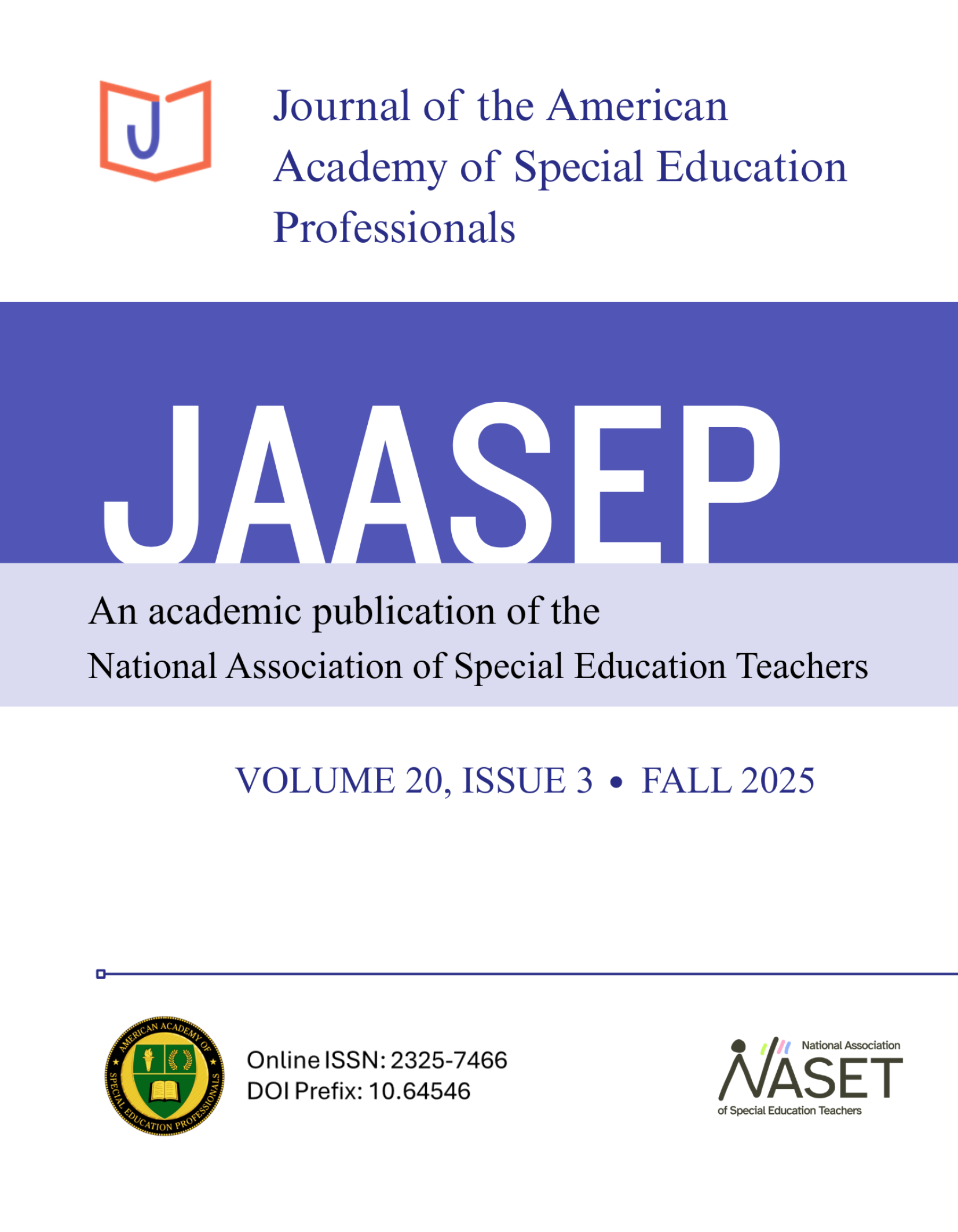Special education and AAC devices: Teachers’ perspectives on training needs and support
Alexandra Da Fonte, M., Boesch, M. C., DeLuca, E. R., Papp, S. K., Mohler, A. E., Holmes, E.
E., Clouse, K. A., Young, R. D., & Urbano, R. (2022). Current preparation status in AAC: Perspectives of Special Education Teachers in the United States. Augmentative and Alternative Communication, 38(1), 29–40. https://doi.org/10.1080/07434618.2022.2046851 DOI: https://doi.org/10.1080/07434618.2022.2046851
Andzik, N. R., Chung, Y.-C., Doneski-Nicol, J., & Dollarhide, C. T. (2017). AAC services in schools: A special educator's perspective. International Journal of Developmental Disabilities, 65(2), 89–97. https://doi.org/10.1080/20473869.2017.1368909 DOI: https://doi.org/10.1080/20473869.2017.1368909
Beukelman, D. R., & Light, J. C. (2020). Augmentative & Alternative Communication: Supporting Children and adults with complex communication needs. Paul H. Brookes Publishing Co.
Bird, M. and Kusior, A. (2016). Interprofessional Collaboration: AAC. Theses and Dissertations. 560. https://ir.library.illinoisstate.edu/etd/560
Blackstone, S. W., Williams, M. B., & Wilkins, D. P. (2007). Key principles underlying research and practice in AAC. Augmentative and Alternative Communication, 23(3), 191–203. https://doi.org/10.1080/07434610701553684 DOI: https://doi.org/10.1080/07434610701553684
Boster, J. B. (2023). Utilising collaborative learning strategies with children who use AAC: Apilot online training program for speech-language pathologists. International Journal of Speech-Language Pathology, 1–9. https://doi.org/10.1080/17549507.2023.2266592 DOI: https://doi.org/10.1080/17549507.2023.2266592
Burnham, S. P., Finak, P., Henderson, J. T., Gaurav, N., Batorowicz, B., Pinder, S. D., & Davies, T. C. (2023). Models and frameworks for guiding assessment for aided augmentative and alternative communication AAC: A scoping review. Disability and Rehabilitation: Assistive Technology, 1–15. https://doi.org/10.1080/17483107.2023.2233986 DOI: https://doi.org/10.1080/17483107.2023.2233986
Klassen, R. M., Tze, V. M., Betts, S. M., & Gordon, K. A. (2010). Teacher efficacy research 1998–2009: Signs of progress or unfulfilled promise? Educational Psychology Review, 23(1), 21–43. https://doi.org/10.1007/s10648-010-9141-8 DOI: https://doi.org/10.1007/s10648-010-9141-8
Leatherman, E. M., & Wegner, J. R. (2022). Augmentative and alternative communication in the classroom: Teacher practices and experiences. Language, Speech, and Hearing Services in Schools, 53(3), 874–893. https://doi.org/10.1044/2022_lshss-21-00125 DOI: https://doi.org/10.1044/2022_LSHSS-21-00125
Lilienfeld, M., & Alant, E. (2005). The social interaction of an adolescent who uses AAC: The evaluation of a peer-training program. Augmentative and Alternative Communication, 21(4), 278–294. ttps://doi.org/10.1080/07434610500103467 DOI: https://doi.org/10.1080/07434610500103467
Locke, P. A., & Mirenda, P. (1992). Roles and responsibilities of Special Education teachers serving on teams delivering AAC services. Augmentative and Alternative Communication, 8(3), 200–214. https://doi.org/10.1080/07434619212331276193 DOI: https://doi.org/10.1080/07434619212331276193
McNaughton, D., Rackensperger, T., Benedek-Wood, E., Krezman, C., Williams, M. B., & Light, J. (2008). A child needs to be given a chance to succeed: Parents of individuals who use AAC describe the benefits and challenges of learning AAC Technologies. Augmentative and Alternative Communication, 24(1), 43–55. https://doi.org/10.1080/07434610701421007 DOI: https://doi.org/10.1080/07434610701421007
Norrie, C. S., Waller, A., & Hannah, E. F. (2021). Establishing context. ACM Transactions on Computer-Human Interaction, 28(2), 1–30. https://doi.org/10.1145/3446205 DOI: https://doi.org/10.1145/3446205
Rackensperger, T. (2012). Family influences and academic success: The perceptions of individuals using AAC. Augmentative and Alternative Communication, 28(2), 106–116. https://doi.org/10.3109/07434618.2012.677957 DOI: https://doi.org/10.3109/07434618.2012.677957
Sanders, E. J., Page, T. A., & Lesher, D. (2021). School-based speech-language pathologists: Confidence in augmentative and alternative communication assessment. Language, Speech, and Hearing Services in Schools, 52(2), 512–528. https://doi.org/10.1044/2020_lshss-20-00067 DOI: https://doi.org/10.1044/2020_LSHSS-20-00067
Senner, J. (2018, December 3). Key AAC Issues - USSAAC. Retrieved November 21, 2023, from https://ussaac.org/speakup/articles/key-aac-issues/
Soto, G. (2009). Special education teacher attitudes toward AAC: Preliminary survey. Augmentative and Alternative Communication, 13(3), 186–197. https://doi.org/10.1080/07434619712331278008 DOI: https://doi.org/10.1080/07434619712331278008
Soto, G. (2012). Training partners in AAC in culturally diverse families. Perspectives on Augmentative and Alternative Communication, 21(4), 144–150. https://doi.org/10.1044/aac21.4.144 DOI: https://doi.org/10.1044/aac21.4.144
Walker, V. L., & Chung, Y.-C. (2022). Augmentative and alternative communication in an elementary school setting: A case study. Language, Speech, and Hearing Services in Schools, 53(1), 167–180. https://doi.org/10.1044/2021_lshss-21-00052 DOI: https://doi.org/10.1044/2021_LSHSS-21-00052
